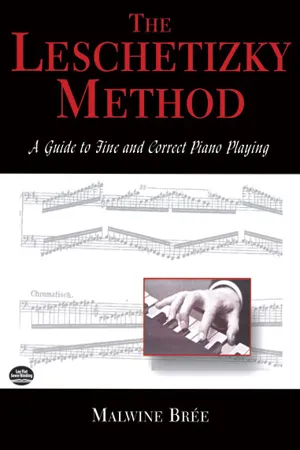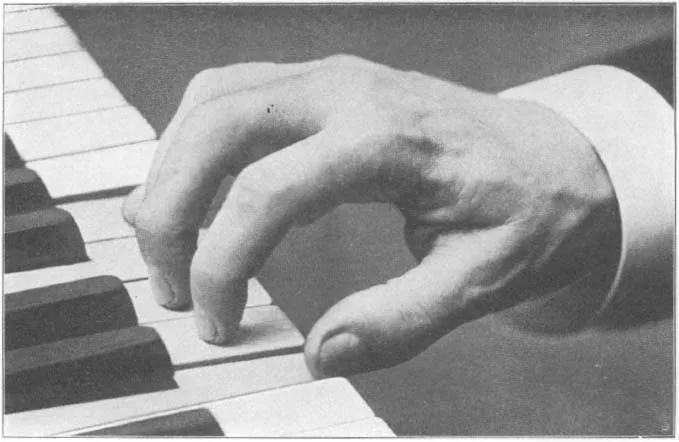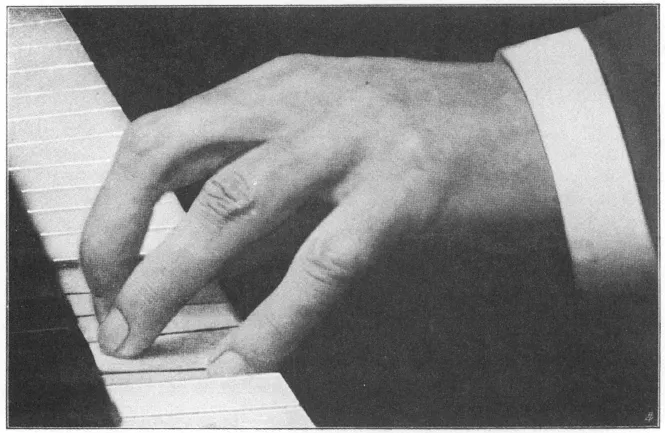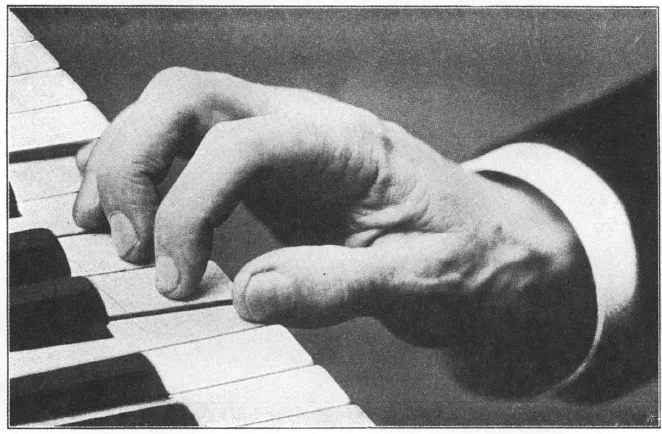![]()
THE BASIS OF THE LESCHETIZKY METHOD
I. ATTITUDE AT THE PIANO
LESCHETIZKY used to say, “Sit easy and erect at the piano, like a good rider on his horse, and yield to the arm movements, as far as needed, just as the horseman yields to the movements of his steed.” One should sit far enough from the keyboard to let the finger-tips rest on the keys without effort when the arms are normally bent, and the feet reach the pedals without stretching. The elbows should not be consciously pressed against the sides, nor should they be moved away from the sides, as a rule; and they should be kept either on a level with the keys or very slightly above them. Owing to the weaker leverage, too low a seat will cause increased exertion in performance, so that the player is forced to raise his shoulders in very ungraceful fashion when trying to use any power.
Many eminent artists place too little stress on a graceful position at the keyboard. They seem to think it enough if the ear is satisfied. But it surely does no harm to influence the listener’s ear through his eye, and make the former more receptive.
“Posing” is not to be approved. The poseur’s usual method is to lean back with an air of being inspired, and to play with the head waving about and the eyes cast upward in rapt gaze. Then there is the careless pose of disdainful ease; or the pianist buries his head in the keys, raising it in pauses to give the audience a questioning smile.
Such procedure makes a more or less comic effect, and will detract from the impression of the best performance. Real feeling in piano-playing is not expressed by an emotional pose. The performer’s art is shown by his fingers, not his face; and if the player has real feeling, it will display itself naturally.
II. POSITION OF THE HAND
The pianist will have little use for a super-refined hand, with slender shape and well-kept nails. A well-trained piano hand is broad, flexible in the wrist, equipped with wide finger-tips, and muscular. The nails must be kept well trimmed, for the elastic finger-tip gives a richer tone than the hard nail.
FIG. 1.—HOW TO HOLD THE RIGHT HAND.
Very large hands are not always a great help to the pianist; but very small ones are usually a disadvantage, even though they are more adapted to bear fatigue, or to acquire the “pearly touch.” Large hands have the advantage in dealing with wide intervals or chords, for which small hands must use rapid skips or some other suitable device. As a matter of fact, there have been great pianists with large hands, and others with small hands. The method of holding the hands is the same in either case. The hand should be given a noticeably arched shape (see Fig. 1 and Fig. 2) ; for the rounding of the hand is the only way to get full strength in the finger-attack. Flat hands and fingers give an amateurish effect. The wrist should be held a trifle lower than the knuckles. Only the tips of the fingers are to touch the keys, and the fingers must be curved in such a way that the tip-joints are held vertically. The thumb is an exception, and strikes the key with its side edge, near the tip. The thumb is held away from the fingers, with its tip-joint bent a little.
FIG. 2.—HOW TO HOLD THE LEFT HAND.
The fingers should now be set on five adjacent white keys, and all (including the thumb) pressed down together. They are to be kept near the front of the keys, where the touch is lightest, but not so near as to be in danger of slipping off. As the fingers are of unequal length, their tips will form a curve, with the middle finger nearest the black keys.
[EDITOR’S NOTE.—It will be found that each hand has a tendency to lean over outward, the right hand to the right side, and the left hand to the left side. This tendency may be counteracted by letting each hand skip a note between the second and third fingers, instead of having each hand press down five adjacent notes. The right hand will thus take C, D, F, G, and A, while the left hand, from the thumb downward, will use the notes A, G, E, D, and C. By practising some of the exercises in this way, as well as on adjacent notes, the student will soon gain control over the position of the hand.]
III. EXERCISE FOR THE WRIST
As soon as the position of the hand is well under control, press the fingers rather firmly on the five white keys, then raise and lower the wrist slowly several times, keeping the fingers on the keys. In this exercise take good care that (1) the hand keeps its rounded shape, (2) the fingers do not slide on the keys, (3) the wrist does not ever rise above its original position, and (4) the upper arm is moved as little as possible. Each hand is to be taken by itself, and the hands alternated to avoid undue effort. The exercise may be repeated frequently. (See Fig. 3.)
IV. SOME GENERAL RULES
It is very important to begin the finger exercises in the right way. They should be learned by heart, like all the music used in practice, so that full attention may be given to the hands. The following important rules may also be adopted.
1. Play all the finger exercises with a light touch at first, and above all play them evenly, with all the fingers giving equal power of tone. Practise each exercise for some days before trying to increase the force of the tone. To make the tones equal, there must be an unequal amount of pressure from the different fingers. The thumb is the strongest; then comes the third finger, then the fifth and second, and last of all is the weak fourth finger. The principle of treating the weakling with indulgence, so often met with in education, must not be followed here. The fourth finger must be made instead to give the greatest effort, to prevent inequality of tone. The ear is the guide, and the student must be able to hear when any undesired inequality begins to be evident. The tones will be equalized only after some practice.
2. Do not begin by repeating the finger exercises until tired. By practising with each hand singly, and changing hands often, the undesired fatigue may be avoided for quite a while. Gradually each hand may be kept at work for a longer time before changing; but even then one must avoid too much exertion. Let the hand rest as soon as it begins to feel heavy. If one does not stop or change at this point, the result will be a...




